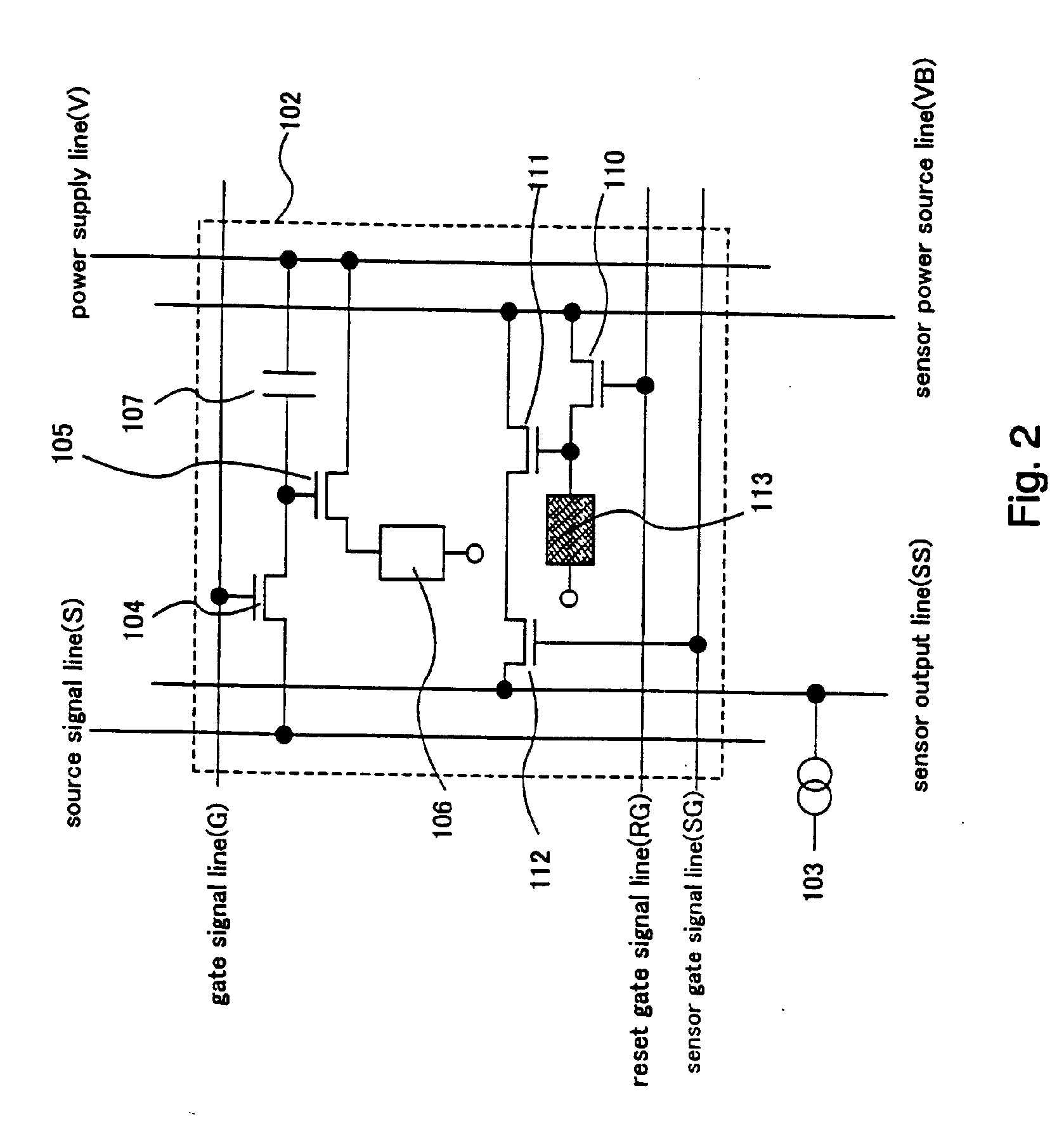Area Sensor and Display Apparatus Provided with an Area Sensor
a technology of area sensor and display apparatus, which is applied in the field of area sensors, can solve problems such as inconsistencies in images
- Summary
- Abstract
- Description
- Claims
- Application Information
AI Technical Summary
Benefits of technology
Problems solved by technology
Method used
Image
Examples
embodiment 1
[0249] A method of driving the switching TFT 104 and the EL driving TFT 105, which control the operation of the EL element 106 shown in FIG. 2, is explained in Embodiment 1. Note that the structure of the sensor portion is the same as that of the embodiment mode, and therefore FIG. 1 and FIG. 2 are referenced.
[0250]FIG. 5 shows a top view of an area sensor of Embodiment 1. Reference numeral 120 denotes a source signal line driving circuit, reference numeral 122 denotes a gate signal line driving circuit, and both control the driving of the switching TFT 104 and the EL driving TFT 105. Further, reference numeral 121 denotes a sensor source signal line driving circuit, reference numeral 123 denotes a sensor gate signal line driving circuit, and both control the driving of the reset TFT 110, the buffer TFT 111, and the selection TFT 112. Note that the source signal line driving circuit 120, the gate signal line driving circuit 122, the sensor source signal line driving circuit 121, an...
embodiment 2
[0274] A method of driving the switching TFT 104 and the EL driving TFT 105 when displaying an image in the sensor portion 101 is explained in Embodiment 2. Note that the structure of the sensor portion is the same as the structure shown by the embodiment mode, and therefore FIG. 1 and FIG. 2 may be referenced.
[0275] A timing chart when performing display of an image in the sensor portion 101 in the area sensor of the present invention by a digital method is shown in FIG. 7.
[0276] First, one frame period F is divided into N subframe periods SF1 to SFN. The number of subframe periods in one frame period also increases as the number of gray scales increases. Note that, when the sensor portion of the area sensor displays an image, one frame period F denotes a period during which all pixels of the sensor portion display one image.
[0277] It is preferable that 60 or more frame periods be provided each second for the case of Embodiment 2. By setting the number of images displayed each s...
embodiment 3
[0295] The electric potential of the opposing electrodes are maintained at the same electric potential as that of the electric power source potential during the address period in Embodiments 1 and 2. Therefore, the EL elements do not emit light. However, the present invention is not limited to this structure. If an electric potential difference is always formed between the opposing electric potential and the electric power source potential, on an order at which the EL elements will emit light, when the electric power source potential is applied to the pixel electrodes, display may also be performed in the address period, similar to the display period.
[0296] However, when combining Embodiment 1, in which the EL elements are used as the light source of the area sensor, with Embodiment 3, it is important that the sensor frame period SF be contained within the frame period for an area sensor which reads in a single color image. Furthermore, it is important that the three subframe perio...
PUM
 Login to View More
Login to View More Abstract
Description
Claims
Application Information
 Login to View More
Login to View More - R&D
- Intellectual Property
- Life Sciences
- Materials
- Tech Scout
- Unparalleled Data Quality
- Higher Quality Content
- 60% Fewer Hallucinations
Browse by: Latest US Patents, China's latest patents, Technical Efficacy Thesaurus, Application Domain, Technology Topic, Popular Technical Reports.
© 2025 PatSnap. All rights reserved.Legal|Privacy policy|Modern Slavery Act Transparency Statement|Sitemap|About US| Contact US: help@patsnap.com



